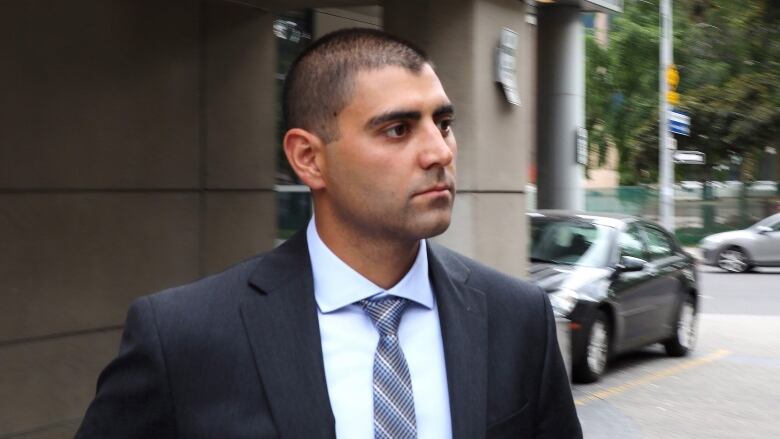'I just wanted him to surrender': Peter Khill tells jury about the moment he shot Jon Styres
Khill said he used training he learned as a reservist when he shot and killed Styres

WARNING: This story contains distressing details.
"They're here."
Peter Khill testified on Wednesday that those words were the first to enter his mind after hearing bangs outside of his home in the middle of a cold February night in 2016.
The bangs came just days after he said he changed the locks on his doors because his girlfriend told him she heard what might have been someone trying to break in.
"I didn't know how many people there were or what they wanted," Khilltold jurors at his trial in theSuperior Court of Justice.
"I just wanted to gain control of the situation.... I wanted to make sure I wasn't going to become a victim, [that Melinda] wasn't going to become a victim."
Not long after that, the former reservist shot Jon Styres to death.
Styres, a Six Nations man, was alone outside the house, trying to stealKhill'struck.
'It was all about his safety,' says defence lawyer
Seven days into his second-degree murder trial, Khill took the stand after Crown attorneys finished presenting their case.
While the jury already knows Khill claims he was trying to defend himselfand his then-girlfriend, Melinda Khill, Wednesday was the first time they heard directly from him.
The number of jurors also fell from 14 to 13 on Wednesday. The media arerestricted from reporting on why.

On Wednesday, when defencelawyerJeffrey Manishenmade his opening statement to jurors, he saidKhill's use of self-defence came, in part, from his training as a Canadian Armed Forces reservist.
"Whereas the Crown said it's all about a truck, to Mr. Khill it was all about his safety and that of [Melinda's safety]," Manishen said.
The past seven days haveseen the Crown bring forward several expert witnesses and Khill's wife to testify. The trial, presided over by Justice Andrew Goodman, hasheard how the situation was described to 911 dispatchers after Styres was shot and howStyres mayhave been standing by the passenger side door ofKhill's truck whenhe was shot.
Khill trained to be 'ready to kill' as reservist
The first witness to testify forthe defence onWednesdaywas Walter Sroka, Khill's superior officer in the 56 Field Regiment in Brantford, Ont.
Khill was a reservist from 2007 to 2011, and also studied to be a millwright.
Reservists are generally volunteer, part-time positions meant to supplement the military when needed.
Sroka testified that Khill did basic training, soldier's training and artillery training, which included practisingwith various guns (but not shotguns).

"Loading and unloading a rifle, they'd carry that out hundreds of times, so they'd never have to think about it when the time came to do it," Sroka said.
He said some key themes of wartime training included being proactive, gaining control of a situation, not working alone and "teach people to be ready to kill if needed" or how to incapacitate a target so they couldn't harm anyone.
Sroka also described how the training taught soldiers like Khill how to handle various guns, how to approach situations in daytime and at night and how to move silently, among other things.
Military and civilian life has 'clear divide'
Crown prosecutor Paul McDermott questionedthe idea that Khill's background as a reservist could explain or justify why he shot Styres instead of calling 911.
"There's a clear divide between the military and civilian life ,,, you're not to cross that as a soldier, are you?" McDermott asked Sroka.
"No," Sroka said.
He also emphasized how the information Sroka provided was in the context of what to do when you're in a war against an enemy.
"One thing you don't do is go charging straight ahead into a situation and make it worse ... you're taught not to do that," McDermott said to Sroka.
"Correct," Sroka responded.
"You never do anything alone ... because if you're alone, you're a potential casualty," McDermott said to Sroka.
"Absolutely," Sroka responded.
Khill left his home alone wearinga T-shirt and boxers, armed with a shotgun to confront Styres in almost pitch-black conditions.
McDermott also stressed that soldiers are trained to avoid a situation that requires lethal force if possible and use as little force as is necessary.
'You need to gain control'
Khilldescribed the night thatchanged his life and ended Styres's.
He said after waking up to loud bangs and seeing the lights from the radio system in his truck glowing, he sprang into action.
Manishen asked Khill if he thought about calling 911 and waiting for police, shining a light toward the truck or opening the window and firing a warning shot.
None of that came to mind, Khill said.
"You don't want to be a victim ... you need to gain control," he said, pointing to his military training.

Khill also said he didn't think about getting dressed because of the sense of urgency.
He described using military techniques to move silently as he went out the back door and walked through a breezeway between his home and the garage.
It led him to Styres, who was within three-and-a-half metres and was bent over the passenger seat of the truck, not sensing Khill's presence.
Khill said when he saw Styres's silhouette, he immediately yelled, "Hey, hands up!"
"It was never my intention to kill Mr. Styres.... I just wanted him to surrender," Khill testified.
"I saw his hands come down together and then start to turn," he said, standing near the witness box, moving his hands from pointing down to above waist height.
That's when Khill said he fired two shots at Styres as fast as he could.
Shortly after, he said, he searched for a gun, feelingStyres's body, but he couldn't find anything.
The trial continues on Thursday, whenKhill will face cross-examination.












_(720p).jpg)


 OFFICIAL HD MUSIC VIDEO.jpg)
.jpg)



























































































